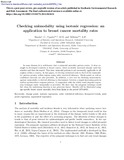Checking unimodality using isotonic regression: an application to breast cancer mortality rates
Fecha
2016Versión
Acceso abierto / Sarbide irekia
Tipo
Artículo / Artikulua
Versión
Versión aceptada / Onetsi den bertsioa
Impacto
|
|
10.1007/s00477-015-1111-8
Resumen
In some diseases it is well-known that a unimodal mortality pattern exists. A clear example in developed countries is breast cancer, where mortality increased sharply until the nineties and then decreased. This clear unimodal pattern is not necessarily applicable to all regions within a country. In this paper, we develop statistical tools to check if the unimodality pattern persists within region ...
[++]
In some diseases it is well-known that a unimodal mortality pattern exists. A clear example in developed countries is breast cancer, where mortality increased sharply until the nineties and then decreased. This clear unimodal pattern is not necessarily applicable to all regions within a country. In this paper, we develop statistical tools to check if the unimodality pattern persists within regions using order restricted inference. Break points as well as confidence intervals are also provided. In addition, a new test for checking monotonicity against unimodality is derived allowing to discriminate between a simple increasing pattern and an up-then-down response pattern. A comparison with the widely used joinpoint regression technique under unimodality is provided. We show that the joinpoint technique could fail when the underlying function is not piecewise linear. Results will be illustrated using age-specific breast cancer mortality data from Spain in the period 1975-2005. [--]
Materias
Change point,
Isotonic regression,
Order restricted inference,
Temporal trends,
Joint point regression,
Segmented regression
Editor
Springer
Publicado en
Stochastic Environmental Research and Risk Assessment, 2016, 30, 1277-1288
Departamento
Universidad Pública de Navarra. Departamento de Estadística e Investigación Operativa /
Nafarroako Unibertsitate Publikoa. Estatistika eta Ikerketa Operatiboa Saila /
Universidad Pública de Navarra/Nafarroako Unibertsitate Publikoa. Institute for Advanced Materials and Mathematics - INAMAT2
Versión del editor
Entidades Financiadoras
This work has been supported by the Spanish Ministry of Science and Innovation (project MTM 2011-22664 jointly sponsored with Feder grants, project MTM 2012-37129 and project MTM2014-51992-R). The work has been also partially supported by the Health Department of Navarre Government (Project 113, Res. 2186/2014).





